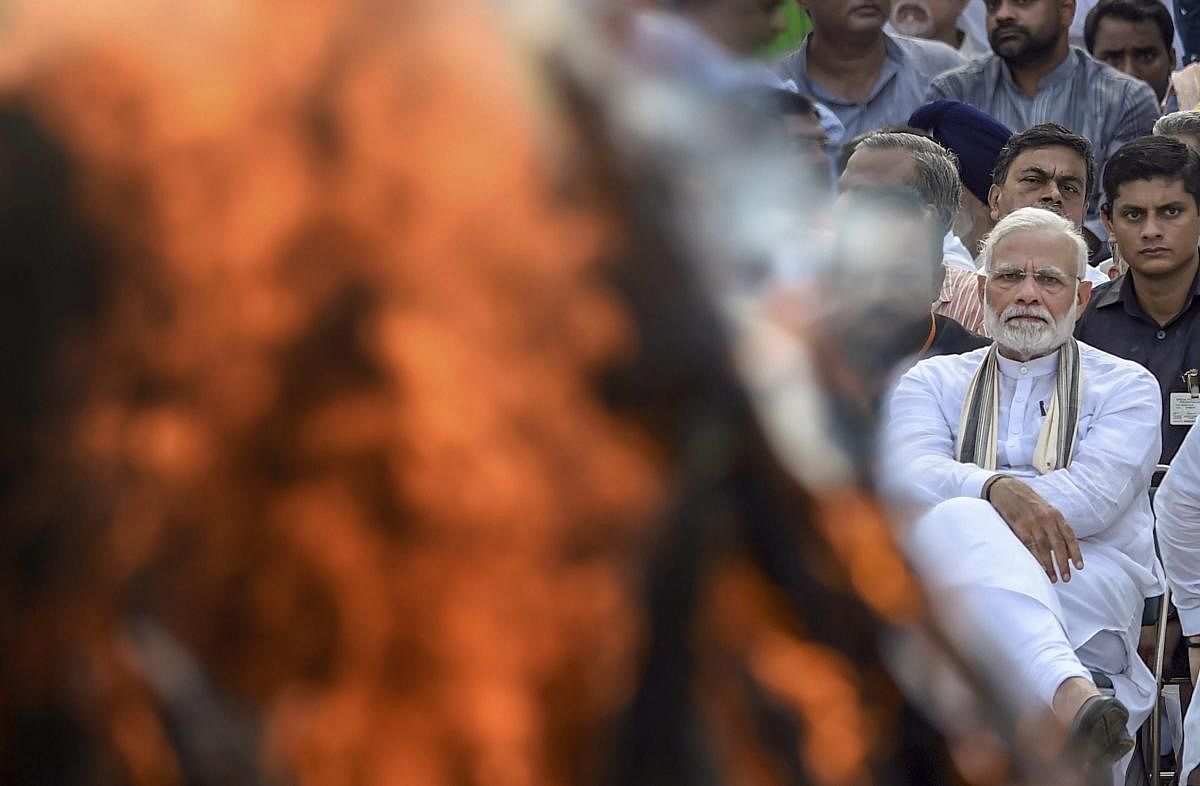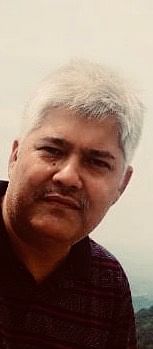
The excitement and enthusiasm with which the BJP has got into event mode to showcase the legacy of its moderate icon, the late Atal Bihari Vajpayee, who died last week, has caught the attention of analysts.
Clearly, the BJP, often accused by the Congress of “trying to usurp” its icons from the freedom struggle, from Sardar Vallabhbhai Patel to B R Ambedkar, is keen that one of its own popular leaders is established well in public memory.
Also, unlike the other textbook icons of the Sangh Parivar like Syama Prasad Mukherjee and Pandit Deen Dayal Upadhyay, Vajpayee, who belongs to a later generation, is someone that at least three generations among current voters can identify with.
On Monday, when the BJP organised a “saarvajanik sarvadaliya prarthana sabha (public, all-party prayer meeting) in Delhi, huge posters and placards of Vajpayee dotted the city.
After Prime Minister Narendra Modi’s nearly five-kilometre walk accompanying the funeral procession of Vajpayee was streamed live on television channels, the BJP has chalked out an elaborate nation-wide “Kalash Yatra.”
During the fortnight-long programme, Vajpayee’s ashes will be immersed in “100 sacred rivers” and rituals performed in cities along the trail. Besides, public discourses are lined up at Mandal and Panchayat levels to propagate the ideas and views of Vajpayee. Politics is all about symbolism and catching signals and responding immediately. The symbolic value of this programme is not lost on political observers.
On Sunday, Vajpayee’s ashes were immersed in the Ganga at Haridwar in Uttarakhand after a high-profile “asthi kalash yatra”, attended by BJP chief Amit Shah, Home minister Rajnath Singh and UP and Uttarakhand chief ministers Yogi Adityanath and Trivendra Singh Rawat.
The next destination is Uttar Pradesh, where 18 ‘kalash’ (urn) containing the ashes will be immersed in 18 places in different rivers across the state.
Not to miss out on Vajpayee’s appeal among Hindi voters, BJP will organise ‘Shraddhanjali Sabha’ (condolence meetings) up to Mandal (division) level across the state after a grand “Sarvadaliya Prarthana Sabha” in Nadwa village on August 23 to which clerics of different religions and leaders of all parties will be invited.
Vajpayee’s ashes will be also be immersed in Gomati river in Lucknow, which he represented in Parliament.
At least one minister and one senior party functionary will attend the Kalash Yatra in every district. The exercise will help the BJP arrest its flagging appeal in UP and help motivate party cadres, whose spirits have dampened after three by-poll defeats and it became clear that they are now faced with the combined strength of Mayawati’s BSP and Akhilesh Yadav’s SP, along with Congress.
The party also plans to organise prayer meetings in all state capitals and districts, especially in the three poll-going states of Madhya Pradesh, Rajasthan and Chhattisgarh. The BJP government in Madhya Pradesh has decided to develop a school in Gorkhi, where Vajpayee studied from class VI to VIII as a top education centre. It has also planned Atal memorials, with huge statues of the leader in Gwalior and Bhopal. His biography will grace the school textbooks next year.
It doesn’t stop there. The Rs 600 crore Global Skill Park being developed in Bhopal will be named after Vajpayee, and so will be the Habibganj railway station. The state government will take the ‘asthi kalash yatra” through every village and panchayat in the state and will hold Atal Smriti Sabha alongside to tell voters of the ideas and achievements of the BJP icon.
Clearly, Chief Minister Shivraj Singh Chouhan, who also has the image of being a moderate, wants to deepen that impression. Elections are just a few months away.
The BJP had got 31% vote share in the 2014 Lok Sabha polls. Analysts say that at least 10% of it were votes from aspirational youth voters and moderates, who went for the ‘Vikas Purush’ image of Modi, not for his ‘Hindu Hriday Samrat’ avatar. Modi’s Sadbhavna fasts in 2012 had helped shed the image of a hardliner, which had stuck to him since the 2002 Gujarat riots. It was felt that while his identification with hard line Hindutva worked in Gujarat, it also alienated moderate Hindus from him.
Modi’s four-minute silence in the middle of a poll rally speech at the time of ‘azan’ in Kharagpur, West Bengal, in 2016, is vivid in people’s memory. Many had interpreted it as an attempt to woo moderate Hindus, if not to reach out to Muslims.
After pursuing a hawkish line on Kashmir for four years, Modi in his last I-Day address, declared that “on Jammu and Kashmir, the path shown by Vajpayeeji is the right one. Vajpayeeji said Insaniyat, Jamhooriyat, Kashmiriyat (humanism, democracy, Kasmiriyat). We want to move ahead on that road.”
The entire party, Modi downwards, falling back on Vajpayee’s image and legacy, extolling his ideas and style of functioning in a coalition, comes at a time when one ally, TDP, has already left the NDA; another, the Shiv Sena, is blowing hot and cold; and some others have also expressed misgivings, even subtly flagging the difference between “today’s NDA and Atal’s NDA.”
It also comes at a time when the electoral limitations of hard line Hindutva politics in the face of regional and caste party alliances, backed by Congress, could be dawning on the BJP. That the party won 282 seats in 2014 by getting just 31% votes, bears out the fact that it gained primarily because of multipolar contests in that election. With opposition parties now closing ranks against it and planning to put up a joint fight, the party needs to go beyond its present voter base in 2019. Clinging to Vajpayee’s charisma and his moderate appeal could help.
